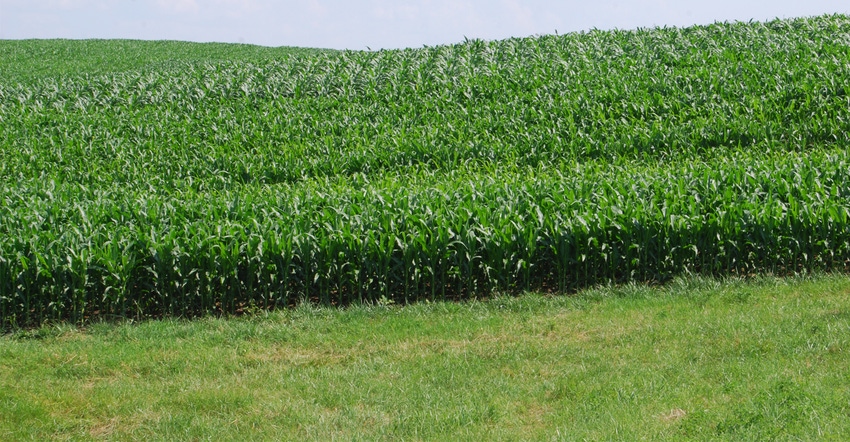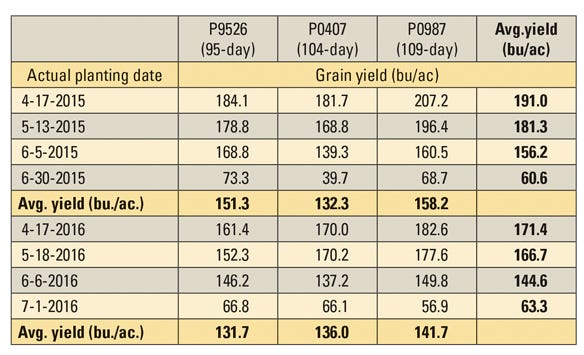June 19, 2018

Spring planting was a challenge in northern Iowa. Repeated snowstorms in April and continuous rain kept many farmers from planting corn during the optimum planting window. Even in early June, there were still people trying to plant corn and areas where no crop was planted.
How will late-May, early-June planted corn fare in 2018? The answer won’t be fully known until harvest arrives and we know when maturity occurred, frost dates, and how summer moisture and heat impacted the crop.
What to expect this season
Research conducted at the Northern Research Farm at Kanawha from 2014 to 2016 looked at the effect of planting date and hybrid maturity. The accompanying table shows results for the three maturities (95-day, 104-day and 109-day corn hybrids) at the targeted planting date of April 15, May 10, June 5 and June 30 for the 2015 and 2016 data. Actual planting dates are shown.

GRAIN YIELD: Corn grain yield of three hybrids at three planting dates at the ISU Northern Research Farm, Kanawha, Iowa, in 2015 and 2016 (as adapted from ISU 2016 Farm Progress Reports, Number RFF-A16109).

When looking at the data in the table in a different way, we note in 2015, corn grain yields decreased by 1.75 bushels per acre per day from April to late June planting and in 2016 corn grain yields decreased by 1.42 bushels per acre per day.
The 109-day maturity hybrid had a higher yield advantage at five of the eight planting dates and shows the importance of staying with full-season maturities as long as possible. It should be noted that all maturities at all planting dates did reach physiological maturity in 2015 and 2016, but also that we had extended fall weather each of those two years. And while it is generally thought that planting earlier gives us higher yield, there are many factors that impact yield potential throughout the growing season. Grain moisture was not reported in this report, but moisture at harvest will influence profitability.
Measuring 2018 growing degree days
So, what does all the early-season, above-average temperatures we’ve had this year mean in terms of growing degree days and maturity? GDDs are a measure of heat or thermal units and having basic knowledge of GDD can help us predict when certain growth stages in corn will happen. For example, a midseason maturity corn hybrid averages 1,400 GDDs to silking and 2,700 GDDs to physiological maturity, as stated in “Modern Corn and Soybean Production.”
When looking at corn planted the week of April 16 and the week of May 28 near Clarion in north-central Iowa through June 5, the April 16 planting date had accumulated 659 GDDs, which is about 113 GDDs above average; and the May planting date had accumulated 197 GDDs, which is about 59 GDDs above average.
If we divide those numbers by the average GGD accumulated per day in June (17 GDD), that would indicate for the April planting date we are a little more than six days ahead of average on GDD accumulation, and for the late-May planting date we are 3.5 days ahead of average.
If I look at the same planting dates for 2017, the April planting date was 27 GDDs behind average and the May planting date was 10 GDDs above normal by June 5 of 2017. Will the warm temperatures persist and continue to push crop development?
Beating first frost
One tool you can use to look at corn growing degree days and the impact on reaching maturity is the Useful to Usable Corn Growing Degree decision support tool hosted by the Midwestern Regional Climate Center. The tool allows you to choose your county, planting date and hybrid maturity. It provides GDD to silking and black layer, as well as historical GDD, and shows you earliest freeze dates and average first freeze dates (historical).
There is a lot of growing season yet to come and there are a lot of questions to be answered. Will normal to above-average temperatures persist? And what does water supply mean for crop growth? While folks in many places north of Highway 18 don’t need any more rain for the time being, other parts of Iowa were still showing up on the drought monitor in early to mid-June. Will nitrogen become limiting in places where we’ve seen a lot of rain?
Also, will temperature stress impact pollination? How will the weather influence disease or insect pressure? How will the challenge of herbicide applications (or lack thereof) influence weed competition? When will we see that killing frost? Will later-planted corn catch up — likely not, but at this point in the growing season, we can note that we are pushing development at a faster pace than average because of the warm weather.
Rieck-Hinz is the Iowa State University Extension field agronomist in north-central Iowa. Contact her at [email protected].
About the Author(s)
You May Also Like






